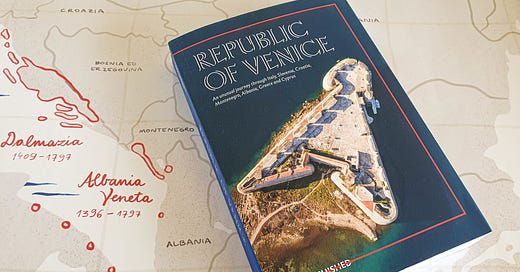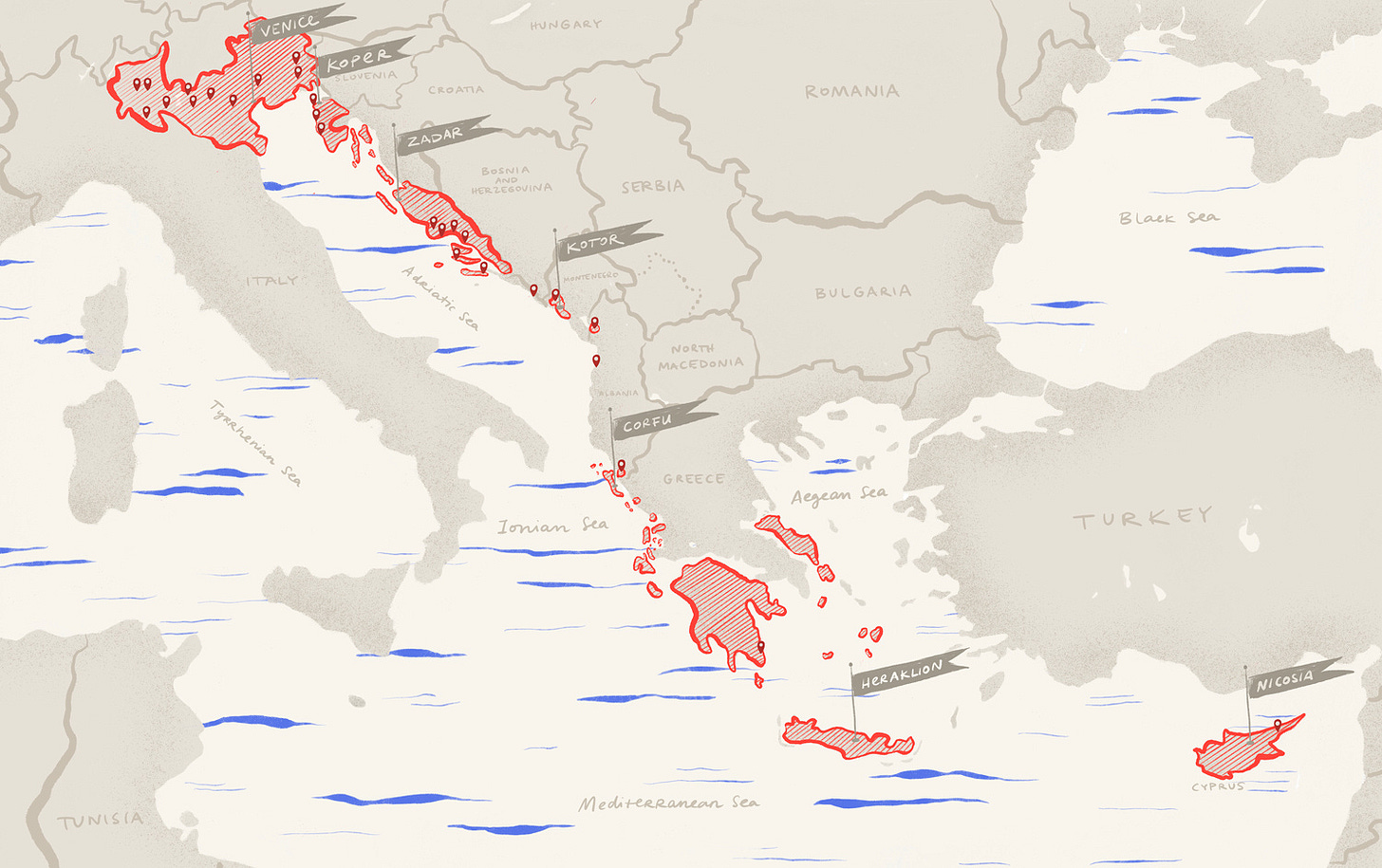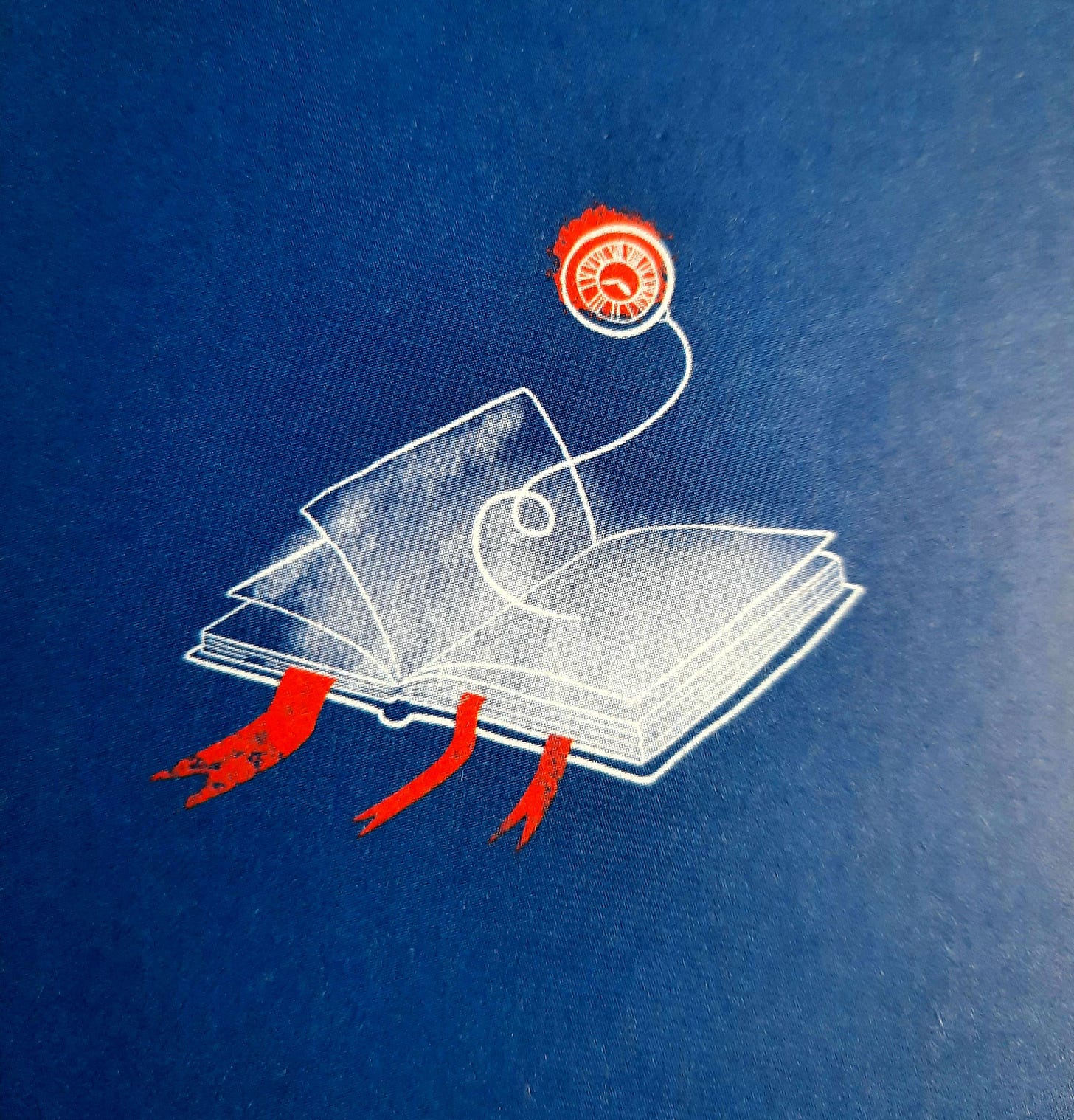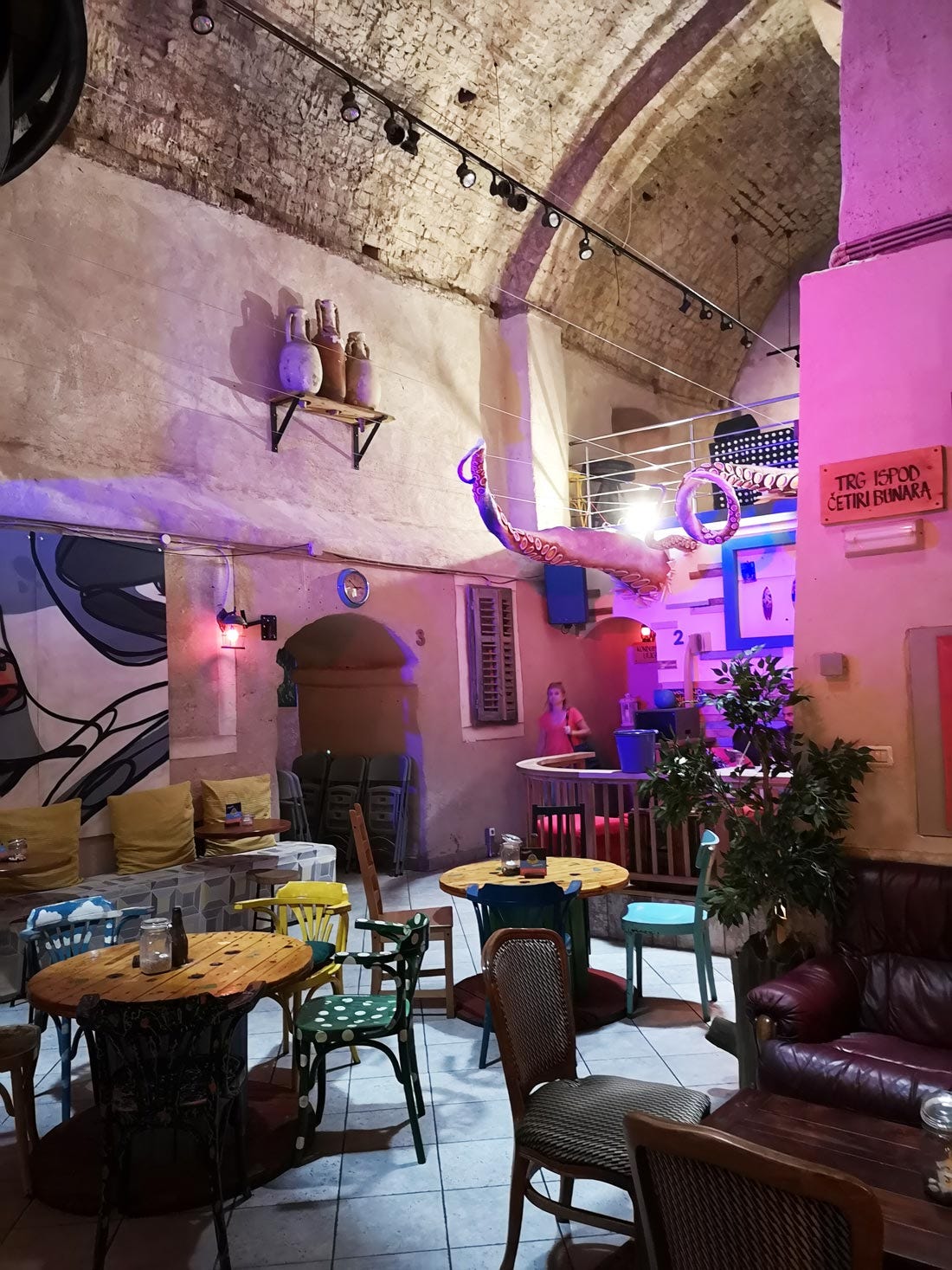S2E32. Journey to extinguished countries
Interview with Giovanni Vale, creator of the project 'Extinguished Countries' and author of the travel guide on the Republic of Venice. An unexpected way to rediscover the legacy of a shared past
Hi,
welcome back to BarBalkans, the newsletter (and website) with blurred boundaries.
Today we find ourselves in a bookstore.
We choose a book, or better, a travel guide. We leaf through it and find all the useful information: places to visit, food to taste, curiosities to discover.
It is a particular travel guide, on the countries bordering the Adriatic, Ionian and Aegean Seas. The most curious thing is that this guide does not follow the current border line, but draws a wider one. A red line.
If you pay more attention, this is the border of the Republic of Venice. A State that has not existed for over 200 years.
Welcome to the world of Extinguished Countries by Italian journalist Giovanni Vale and Croatian translator Ivana Pogačić.
Extinguished countries
Giovanni, what is the sense of a travel guide about a State that no longer exists?
«The idea is to realize a series of travel guides on extinguished countries, as the name of the publishing house.
I think society is ready for such a journey, different from the others that follow contemporary borders.
We know that extinguished countries have left an important legacy on the present.
A travel guide of this kind can also be the pretext to make the traveler understand that social identity is the result of many different layers and that nationalism does not lay on any foundation».
Where did the idea come from?
«It came from a chat with my wife Ivana in the winter of five years ago in Dubrovnik. We realized how much Game of Thrones was present in the cultural and tourist offer of the city, one of the sets of the TV series. Part of the advertised tours followed the places where the most famous scenes were shot.
This fact surprised us and also left us with a bit of sour taste, because the Republic of Ragusa - another extinguished country - has an exceptional history, in line with the American TV series, full of intrigues and twists.
So we began a reflection on how to write and how to use travel guides of extinguished countries».
And how did the idea materialize?
«We decided to start with the Republic of Venice, both because it was not an overly extended territory to cover, and also because it was closer to me, as I come from Friuli (Italy) and live in Zagreb (Croatia).
The main issue was the way to tell the story of an extinguished country that split into several others, each one with its own point of view, or even more than one. I did not want to fall into the trap of writing a nostalgic book about the Republic of Venice.
I conducted hundreds of interviews - with historians, museum directors, art historians, writers, journalists, chefs - in seven countries: Italy, Slovenia, Croatia, Montenegro, Albania, Greece and Cyprus.
And then the second big step. In March 2020 we launched a crowdfunding campaign, to assess public interest. In three weeks, we managed to raise more than 25 thousand euros and we pre-sold many guides even in the United States, we did not expect that.
Above all, a lot of curiosity emerged. Many people found this way of traveling to discover Europe interesting.
With the funds raised, we opened a publishing house and we put together a small team of designers, translators and photographers. And finally, we produced the first guide, in Italian and English, which was printed in the summer of 2021».
What was the greatest difficulty and satisfaction in realizing the guide?
«The main difficulty was doing everything by ourselves, without any loans. The amount raised through crowdfunding may seem like a lot, but it really was not to print a book, pay professionals and taxes. For example, I did not get paid for the interview and writing work.
The greatest satisfaction is the other side of the coin. Despite the fact that we had no publishers - on the contrary, we opened a publishing house ourselves - the ongoing project continues to be well received.
The quality of the project has been recognized, the meaning has been understood and appreciated. In short, it was a right insight, in line with the trajectory of Europe. It is possible to discuss the past in a way that is not rancorous and nostalgic, to listen to other points of view while reasoning on a common identity».
Boundaries, heritage, identity
The guide follows a red line, which is the border of the Republic of Venice. What choice was made on this aspect?
«This was one of the most complex issues, about which border we have to consider as we talk about the Republic of Venice. It is something that concerns all extinguished countries, because their geography has changed over time.
To simplify, the Republic of Venice existed for over a millennium - from its legendary foundation in 421 to the Treaty of Campo Formio in 1797 - and its form underwent considerable changes over the centuries.
We had to solve the problem of the map to consider. At the end, we chose the Republic at its height, but also a diachronic map, considering territories that were part of it in different periods.
The important thing was that these territories were controlled in a lasting way, that they played a significant role and that they still show a legacy in the present days. At the same time we excluded temporary conquests, such as Trieste.
The red line is the border of that time, which has vanished today. But it also represents the red thread of the legacy that the extinguished country left where it existed».
At the same time, the guide is divided into seven chapters, like the seven contemporary States covered by the Republic of Venice. Why?
«Contemporary borders were important anyway, because the idea is to have a real travel guide, not a historical essay. If we had divided the Republic of Venice according to the territorial units of that time, the traveler would have been disoriented.
In the introduction, the territorial units Stato da terra and Stato da mar are explained, along with the history, the itineraries, the relationships with other States and the key-words. But contemporary borders remain.
The guide investigates State by State as a reportage, with a picture, a map and a description of territories and cities, and with blue pages on specific details: recipes, special places, trades, characters, curiosities, interviews....
In this way, the traveler knows that he is crossing an existing border and can also see the different approaches on the national identity and the relation with the Venetian past.
The goal of the guides is not to question the current borders or to argue that the borders of the past were more correct. But to show that, in a way, both exist».
Is the legacy of the Republic of Venice frictional or shared?
«The general trend I have perceived is that we are moving from a legacy that created a lot of friction to a legacy that can be shared.
For example, if once St. Mark’s lions were chiseled out in Greece and Dalmatia to erase that past, nowadays Greek and Croatian cities are using European or Veneto Region funds to renovate Venetian fortresses and towers.
Although the motivation is economic and touristic, at the same time historians are aware that the approach has changed. Croatian historian Lovorka Čoralić says that “today, there is no longer the ideological weight of the past”.
So, it is possible to work on the archives, reconstructing life during the Serenissima and dispelling false myths. Like the idea of Venice as a regional power that for centuries only stole and oppressed Croatia, while many Dalmatian nobles and merchants made money during that period.
There is a positive transformation, which permeates the whole series of guides. The time has come for this kind of reflection, despite the nationalist resurgence that we still see».
In your journey, have you encountered any cultural bridge overcoming borders?
«An important case concerns the Venetian defense works ‘alla moderna’, which have been registered as a UNESCO heritage site by Italy, Croatia and Montenegro. Although the site is incomplete, it shows that together we can defend and promote a common heritage.
Gastronomy is another good example. During the presentation of the guide in Treviso, a chef from Corfu was invited at the event, to prepare sarde in saor and bourdeto together with a local colleague, reinventing these common recipes.
The cultural space that allows this approach is the European Union, including with its financing EU institutions. We understand that we inherit the same cultural heritage and that we have the tools to defend and promote it together».


What about Yugoslavia
‘Extinguished countries’ was born and developed as a series of guides. What is in the pipeline?
«We decided to start working on the Habsburg Empire. It is an extinguished country larger than the Republic of Venice, also in terms of contemporary states involved, which are 12.
We chose it to root the project in this territory, while starting to get out of the area already covered and involving other journalists and professionals.
Slowly, if we continue to grow, in the future we could also consider the Hanseatic League, the Ottoman Empire and other non-European states. Because the issue of borders, legacy of the past and identity is universal».
Yugoslavia is also a country that no longer exists. Have you already thought about whether to include it in the series?
«Absolutely, we have already discussed about it. Yugoslavia was one of the extinguished countries that we considered from the very beginning, even before choosing the Republic of Venice.
We decided not to start with Yugoslavia because it would have been a huge and delicate challenge: it disappeared recently and we did not want the Extinguished Countries project to be received in the wrong way, especially in this region.
Before hitting a nerve, we wanted to make it clear that the series is not nostalgic, but realized through intersecting viewpoints.
A few months ago, I was at the Red History Museum on the Yugoslav history, in Dubrovnik, and the two managers told me that many tourists ask for a Yugoslavia guide.
This fact suggests that there may be room for a concise, travel-friendly text that overcomes nationalism».
How difficult would it be to realize it, given the proximity since the end of Yugoslavia, the divisions over its legacy and the wounds opened by the wars?
«Certainly, there would be many disclaimers to make, presenting the many different points of view. Probably, the most critical issue about the end of Yugoslavia is that there is no historical judgment yet and there are ongoing judicial processes.
It would be very difficult to write about it or it would require a great work of cultural diplomacy. In any case, the aim of these texts is not to resolve the debate, nor to close once and for all the questions that are still open.
And this also applies to the Republic of Venice. The preface talks about the Stato da mar: was it a form of Commonwealth or ante litteram colonialism? The guide does not try to give an answer, but presents the different points of view.
Coming back to Yugoslavia, there would be many aspects to highlight. Clearly, there are also historical truths and falsehoods to evaluate, perhaps this would be the most complex aspect of writing a travel guide».
If you were to write a Yugoslavia guide right now, where would you start?
«There are several intriguing places.
The city I am most fond of is Belgrade, but that would be too easy: this was the capital, with the buildings bombed by NATO and left as a warning.
A more fanciful one is Petrova Gora, where there is one of the anti-fascist monuments of Yugoslavia: using a building as a starting point, as it could also be with one of Tito’s abandoned villas.
The third is Korčula. Here live the descendants of Fitzroy Maclean, the point of contact between British intelligence and Yugoslav partisans during World War II and the only foreigner citizen Tito allowed to buy a house. And Korčula was also home to the party’s summer school. In short, behind the tourist appearance of the island lies the history of the resistance and the birth of Yugoslavia».
Pit stop. Sittin’ at the BarBalkans
We have reached the end of this piece of road.
The travel guide on the extinguished country of the Republic of Venice leaves several suggestions also for our bar, the BarBalkans.
Giovanni, what can you recommend?
«To drink, I recommend the bevanda, made with white wine and still water.
The place to go, I recommend café Azimut, in Šibenik, which is located inside an old Venetian cistern. Realized in 1453 and used until the late 19th century, it was one of the largest in the Adriatic area and provided drinking water to a city with no water resources.
In 2013, an independent cultural center was established inside of the Venetian cistern. Now you can drink a coffee below sea level, while attending a concert, exhibition or literary evening.
Or finally, I recommend one of my favorite places, a bar on the island of Lastovo, which was part of the Republic of Ragusa. Indigo bar has an open-air terrace, and in the summer mornings there is nothing better than having coffee and croissant here, looking down at the sea from above».
Let’s continue the BarBalkans journey. We will meet again in two weeks, for the 33rd stop.
Next Saturday, don’t forget the new analysis in the Langer-Sassoli Project notebook, on barbalcani.eu.
A big hug and have a good journey!
Did you like this newsletter? Forward it to someone you think might be interested in!
BarBalkans is a free newsletter. Behind these contents there is a lot of work undertaken.
If you want to help this project to improve, I kindly ask you to consider the possibility of donating. As a gift, every second Wednesday of the month you will receive a podcast with an article about the dissolution of Yugoslavia.
Every month you can listen to the preview of BarBalkans - Podcast on Spreaker and Spotify.
Pay attention! The first time you will receive the newsletter, it may go to spam, or to “Promotions Tab”, if you use Gmail. Just move it to “Inbox” and, on the top of the e-mail, flag the specific option to receive the next ones there.
As always, I thank you for getting this far with me. Here you can find all the previous newsletters.









